Russel Brothers Limited OWEN SOUND, ONTARIO Steelcraft Boat Builders
 |  |
|
| Adamsville / Burrard
- Particulars Of Canadian War Vessels Building & Projected by Naval Service Headquarters (D. N. C. Dept.) 1943 - 1945: Adamsville commissioned 1943 [C.N.800] Russel Bros., Owen Sound. Ville Class Tug ADAMSVILLE YTS 582. Then BURRARD. Laid Down: 23 Nov 1943. Delivered to the RCN: 12 Jan 1944. Fate: Sold in 1976. Final disposition unknown.
Built by Russel Brother's Ltd, Owen Sound, Ont., Adamsville was delivered by CN rail to Vancouver to serve on the West coast. After the war, Adamsville continued service as a CNA. She later became a tender to the reserve unit HMCS Discovery and was renamed Burrard.
Janes Fighting Ships 1990 - 1991: Burrard ex - Adamsville [YTL 582]. Built by Russel Bros. Launched January 8, 1944. GAO Notes: Still in Navy ownership at Esquimalt, B.C.
ADAMSVILLE
Namesake town: Adamsville, PQ
Ville Class tug for RCN
Laid down: 23 Nov 1943
Penant: YTS 582
Registration: ???
Hull No. ???
Delivered by CN Rail to Vancouver
Commissioned: 01 Dec 1943, CN 800
1943-1974: Served as harbour tug Navy dock yard, Esquimault BC
1974: Transferred to HMCS Discovery Reserve, Deadmanís Island, Vancouver
Renamed Burrard
1974-1977: HMCS Discovery Reserve Deadmanís Island Vancouver
1977: 21 May: Transferred to HMCS Nonsuch Reserve Edmonton
Training vessel on Lake Wabamum
2007: Sold to private sector and shipped to west coast
Converted by Kleaman Marine North Vancouver BC
Working in the Nass River area north of Pr. Rupert BC
|
Adamsville RCN Official Photo E-6498-1_DHH courtesy nauticapedia.ca.
Adamsville: In 1944-1946 she was owned by the Royal Canadian Navy. She became an auxiliary vessel (CNAV/CFAV) serving 1946-1976. She was a Ville-class small harbour tug at Esquimalt. In 1974 she was transferred to HMCS Discovery.
source:
http://www.nauticapedia.ca/dbase/Query/Shiplist4.php?&name=Adamsville%20(H.M.C.S.)&id=1029&Page=1&input=adamsville
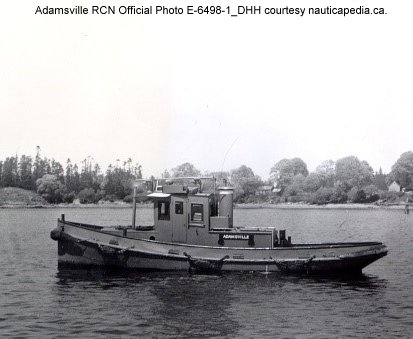 |
Clippings courtesy Leigh Cossey, Feb. 4, 2020.
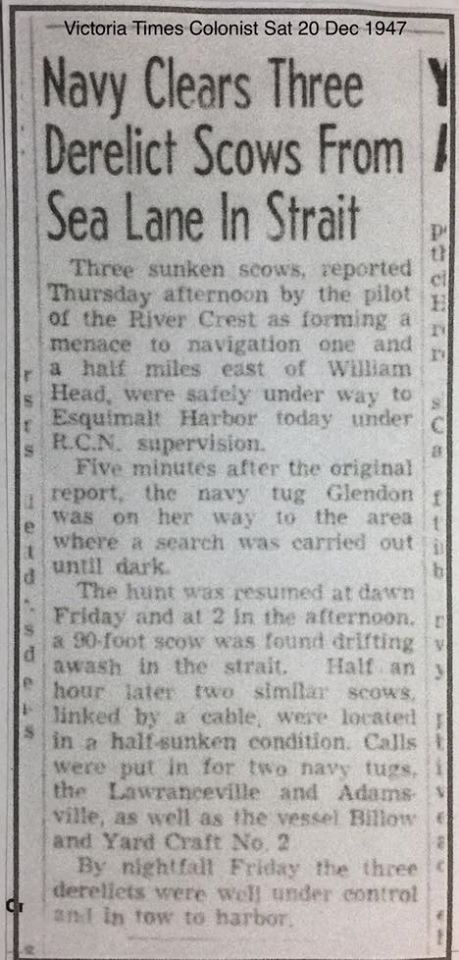 |
Victoria Times Colonist, Sat. Dec. 20, 1947.
clipping courtesy Leigh Cossey, Jan. 27, 2020.Navy Clears Three Derelict Scows From Sea Lane In Strait. Three sunken scows, reported Thursday afternoon by the pilot of the River Crest as forming a menace to navigation one and a half miles east of William Head, wer safely underway to Esquimalt Harbor today under R.C.N. supervision. Five minutes after the original report, the navy tug Glendon was on her way to the area where a search was carried out until dark.
The hunt was resumed at dawn Friday and at 2 in the afternoon, a 90-foot scow was found drifting awash in the strait. Half an hour later two similar scows, linked by a cable, were located in a half-sunken condition. Calls were put in for two navy tugs, the Lawrenceville and Adamsville, as well as the vessel Billow and Yard Craft No. 2. By nightfall Friday the three derelicts were well under control and in tow to harbor.
|
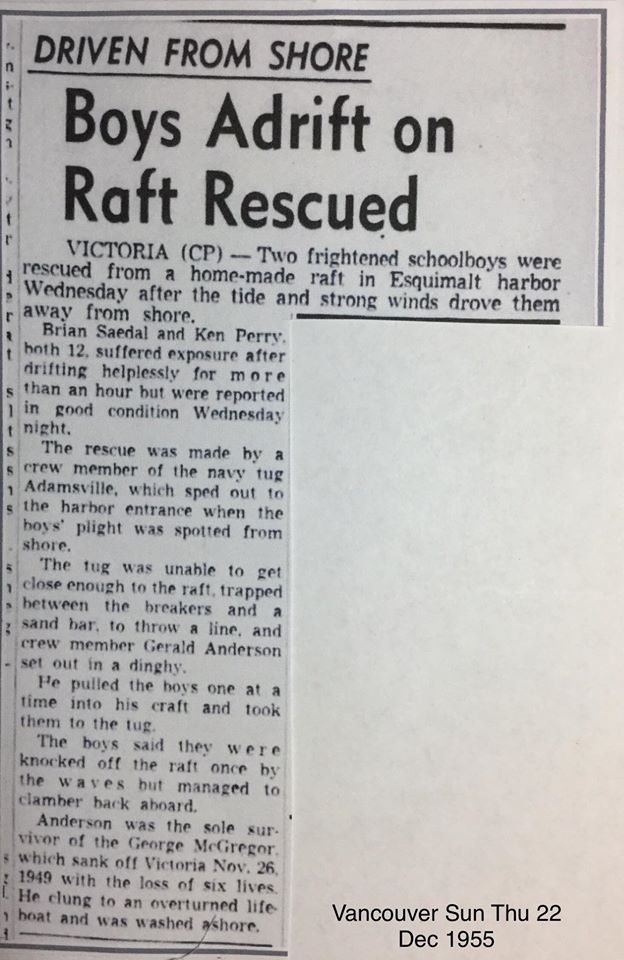 |
Vancouver Sun, Thurs. Dec. 22, 1955.
clipping courtesy Leigh Cossey, Jan. 27, 2020.DRIVEN FROM SHORE Boys Adrift on Raft Rescued. Two frightened schoolboys were rescued from a home-made raft in Esquimalt Harbor Wednesday after the tide and strong winds drove them away from shore. Brian Saedal and Ken Perry, both 12, suffered exposure after drifting helplessly for more than an hour but were reported in good condition Wednesday night.
The rescue was made by a crew member of the navy tug Adamsville, which sped out to the harbor entrancewhen the boys' plight was spotted from shore. The tug was unable to get close enough to the raft, trapped between the breakers and a sand bar, to throw a line, and crew member Gerald Anderson set out in a dinghy. He pulled the boys one at a time into his craft and took them to the tug.
The boys said they were knocked off the raft once by the waves but managed to clamber back aboard. Anderson was the sole survivor of the George McGregor, which sank off Victoria Nov. 26, 1949 with the loss of six lives. He clung to an overturned lifeboat and was washed ashore.
|
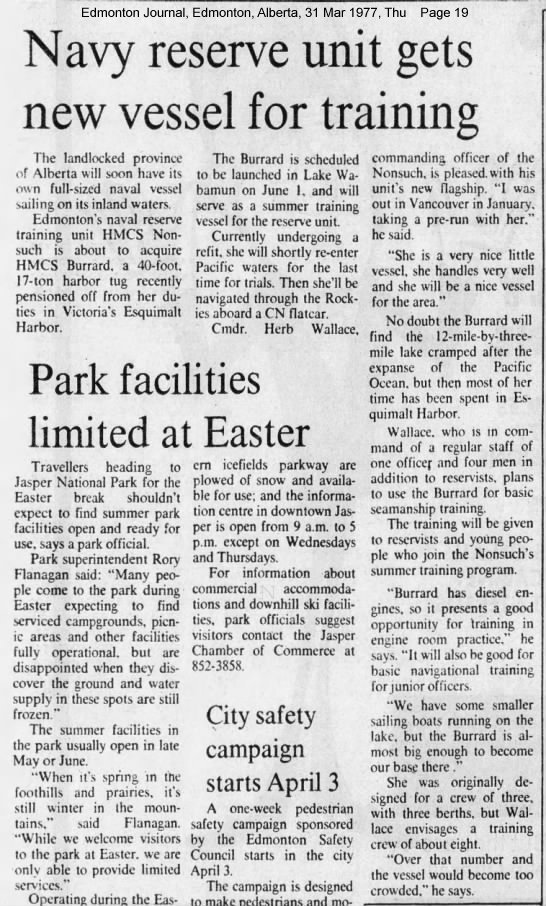 |
Edmonton Journal, Thurs Mar. 31, 1977. Navy reserve unit gets new vessel for training.
The landlocked province of Alberta will soon have its own full-sized naval vessel sailing on its inland waters. Edmonton's naval reserve training unit HMCS Nonsuch is about to acquire HMCS Burrard, a 40-foot. 17-ton harbor tug recently pensioned off from her duties in Victoria's Esquimalt Harbor.
The Burrard is scheduled to be launched in Lake Wabamun on June 1, and will serve as a summer training vessel for the reserve unit. Currently undergoing a refit, she will shortly re-enter Pacific waters for the last time for trials. Then she'll be navigated through the Rockies aboard a CN flatcar. Cmdr. Herb Wallace, commanding officer of the Nonsuch, is pleased with his unit's new flagship. "I was out in Vancouver in January, taking a pre-run with her." he said. "She is a very nice little vessel, she handles very well and she will be a nice vessel for the area."
No doubt the Burrard will find the 12-mile-by-three-mile lake cramped after the expanse of the Pacific Ocean, but then most of her time has been spent in Esquimalt Harbor. Wallace, who is in command of a regular staff of one officer and four men in addition to reservists, plans to use the Burrard for basic seamanship training. The training will be given to reservists and young people who join the Nonsuch's summer training program. "Burrard has diesel engines, so it presents a good opportunity for training in engine room practice." he says. "It will also be good for basic navigational training for junior officers. "We have some smaller sailing boats running on the lake, but the Burrard is almost big enough to become our base there ." She was originally designed for a crew of three, with three berths, but Wallace envisages a training crew of about eight. "Over that number and the vessel would become too crowded," he says.
|
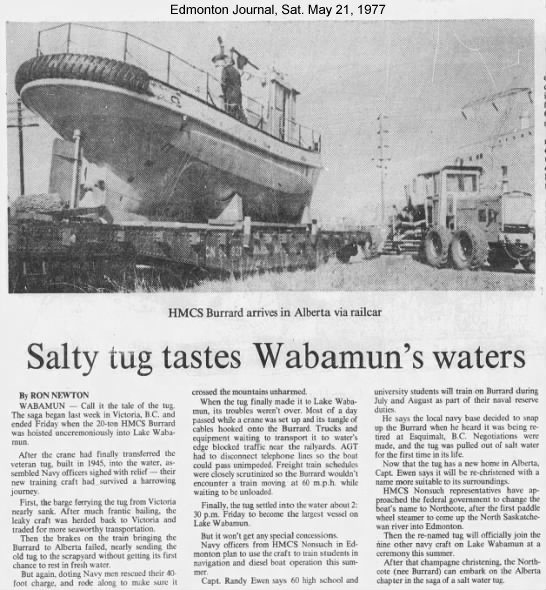 |
Edmonton Journal, Sat. May 21, 1977. Salty tug tastes Wabamun's waters.
Photo caption: HMCS Burrard arrives in Alberta via railcar. Salty tug tastes Wabamun's waters By RON NEWTON WABAMUN Call it the tale of the tug. The saga began last week in Victoria, B.C. and ended Friday when the 20-ton HMCS Burrard was hoisted unceremoniously into Lake Wabamun.
After the crane had finally transferred the veteran tug, built in 1945, into the water, assembled Navy officers sighed with relief their new training craft had survived a harrowing journey. First, the barge ferrying the tug from Victoria nearly sank. After much frantic bailing, the leaky craft was herded back to Victoria and traded for more seaworthy transportation. Then the brakes on the train bringing the Burrard to Alberta failed, nearly sending the old tug to the scrapyard without getting its first chance to rest in fresh water. But again, doting Navy men rescued their 40-foot charge, and rode along to make sure it crossed the mountains unharmed.
When the tug finally made it to Lake Wabamun, its troubles weren't over. Most of a day passed while a crane was set up and its tangle of cables hooked onto the Burrard. Trucks and equipment waiting to transport it to water's edge blocked traffic near the railyards. AGT had to disconnect telephone lines so the boat could pass unimpeded. Freight train schedules were closely scrutinized so the Burrard wouldn't encounter a train moving at 60 m.p.h. while waiting to be unloaded. Finally, the tug settled into the water about 2: 30 p.m. Friday to become the largest vessel on Lake Wabamun.
But it won't get any special concessions. Navy officers from HMCS Nonsuch in Edmonton plan to use the craft to train students in navigation and diesel boat operation this summer. Capt. Randy Ewen says 60 high school and university students will train on Burrard during July and August as part of their naval reserve duties. He says the local navy base decided to snap up the Burrard when he heard it was being retired at Esquimalt, B.C. Negotiations were made, and the tug was pulled out of salt water for the first time in its life.
Now that the tug has a new home in Alberta, Capt. Ewen says it will be re-christened with a name more suitable to its surroundings. HMCS Nonsuch representatives have approached the federal government to change the boat's name to Northcote, after the first paddle wheel steamer to come up the North Saskatchewan river into Edmonton. Then the re-named tug will officially join the nine other navy craft on Lake Wabamun at a ceremony this summer. After that champagne christening, the Northcote (nee Burrard) can embark on the Alberta chapter in the saga of a salt water tug.
|
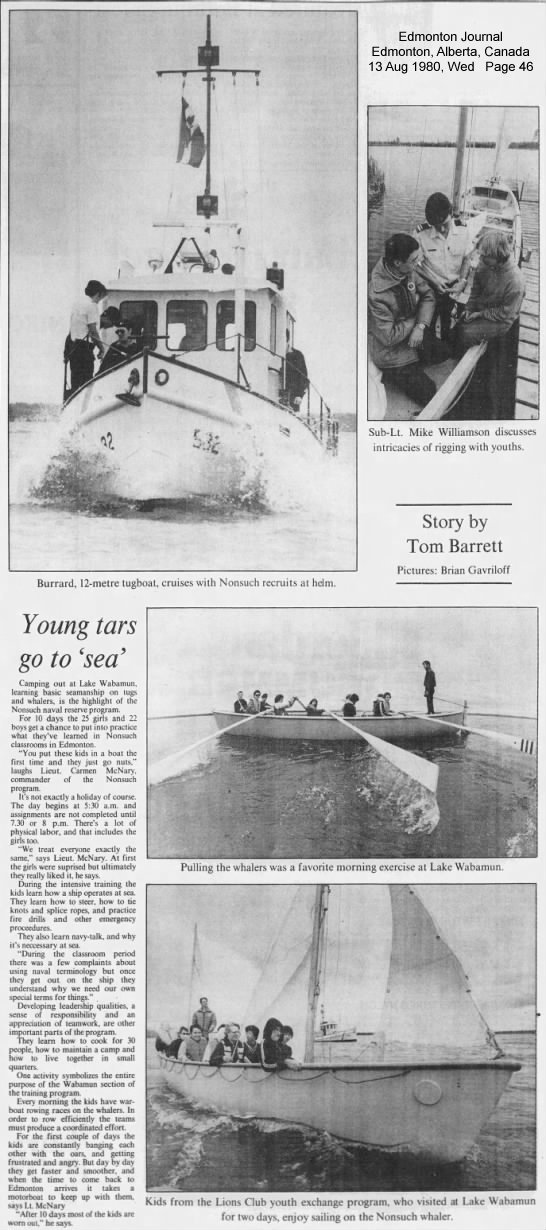 |
Edmonton Journal, Aug. 13, 1980. Young Tars Go To Sea.
Photo captions: 1) Burrard, 12-metre tugboat, cruises with Nonsuch. 2) Sub-Lt. Mike Williamson discusses intricacies of rigging with youths. 3) Pulling the whalers was a favorite morning exercise at Lake Wabamun. 4) Kids from the Lions Club youth exchange program, who visited at Lake Wabamun for two days, enjoy sailing on the Nonsuch whaler.
Camping out at Lake Wabamun, learning basic seamanship on tugs and whalers, is the highlight of the Nonsuch naval reserve program. For 10 days the 25 girls and 22 boys get a chance to put into practice what they've learned in Nonsuch classrooms in Edmonton.
"You put these kids in a boat the first time and they just go nuts," laughs Lieut. Carmen McNary, commander of the Nonsuch program. It's not exactly a holiday of course. The day begins at 5:30 a.m. and assignments are not completed until 7.30 or 8 p.m. There's a lot of physical labor, and that includes the girls too. "We treat everyone exactly the same," says Lieut. McNary. At first the girls were suprised but ultimately they really liked it, he says.
During the intensive training the kids learn how a ship operates at sea. They learn how to steer, how to tie knots and splice ropes, and practice fire drills and other emergency proceedures. They also learn navy-talk, and why it's neccessary at sea. "During the classroom period there was a few complaints about using naval terminology but once they get out on the ship they understand why we need our own special terms for things."
Developing leadership qualities, a sense of responsibility and an appreciation of teamwork, are other important parts of the program. They learn how to cook for 30 people, how to maintain a camp and how to live together in small quarters. One activity symbolizes the entire purpose of the Wabamun section of the training program. Every morning the kids have war-boat rowing races on the whalers. In order to row efficiently the teams must produce a coordinated effort. For the first couple of days the kids are constantly banging each other with the oars, and getting frustrated and angry. But day by day they get faster and smoother, and when the time to come back to Edmonton arrives it takes a motorboat to keep up with them, says Ll McNary "After 10 days most of the kids are worn out," he says. Kids from the Lions Club youth exchange program, who visited at Lake Wabamun for two days, enjoy sailing on the Nonsuch whaler. Story by Tom Barrett Pictures: Brian Gavriloff
|
A huey helicopter from 408 Squadron lifts a pair of SAR technicians off the deck of CFAV Burrard while working jointly with the Naval Reserves from HMCS Nonsuch, Sept. 1980.
From page 166, Appendix A: Vessels of the Naval Reserve of Canada, Citizen Sailors: Chronicles of Canada's Naval Reserve, 1910-2010 edited by Richard Howard Gimblett, Michael L. Hadley.
Ville Class ex Canadian Navy Tug - in storage in Winnipeg.
from http://www.kleamanmarine.com/conversion_stories.htm
Arrived in Vancouver.
from http://www.kleamanmarine.com/conversion_stories.htm
c. 2007 working in the Nass River area.
from http://www.kleamanmarine.com/conversion_stories.htm
For more Russel exhibits visit Owen Sound Marine & Rail Museum 1165 1st Ave West, Owen Sound, ON N4K 4K8
(519) 371-3333  http://marinerail.com http://marinerail.com |
|
|
|
|
|